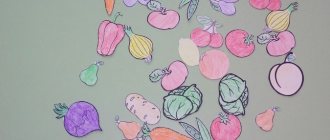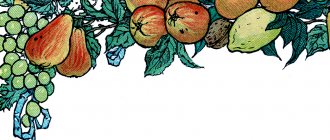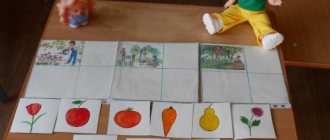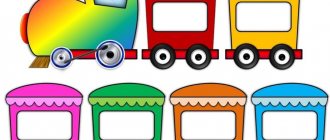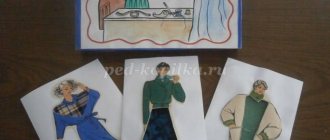Behavioral game “Dos and Don’ts”
Alena Kalashnikova
Behavioral game “Dos and Don’ts”
Game “
Dos and Don’ts ” The favorite word of children at any age is “give” or “I want”, they don’t think about what is not allowed , in order for children to understand you can conduct a behavioral game .
Goal: to introduce children to the diversity of needs and disabilities . Learn to determine what is possible and what is not.
Rules: determine which concept is “ possible ”
or
“
not allowed ” refers to the object depicted on the cardboard, and glue the picture onto the corresponding panel.
The pictures are associated with the rules of behavior in various situations: at the table, on the street, in transport, in society, and so on.
Material: Pictures with positive and negative behavior , as well as a board where these pictures are attached.
“We cannot forget these roads” 70 years of Victory The holiday is held with preliminary preparation of children. literary and musical composition dedicated to May 9” for older preschoolers.
Consultation “Relationship between children and adults: do’s and don’ts” Not everything in life works out the way we would like, and sometimes circumstances turn out to be stronger than us. In moments of failure, we want to.
“This is my Motherland - it cannot be divided.” Photo report on May 9, Victory Day is a holiday, It’s fireworks in the evening. There are many flags at the parade, People sing joyfully! Veterans with orders Remember the war and talk.
Art therapy in correctional work with preschoolers (behavioral and emotional-volitional spheres) “Art therapy” (art (English) - art, therapeia (Greek) - care, treatment) is understood as care for psychological and emotional health.
Didactic game on life safety “What is possible, what is not” mmDidactic game on life safety “What is possible, what is not” Preschool age is the most important period when formation. Safety game "Do's and Don'ts" Unfortunately, many accidents happen at home. Our house is filled to capacity with various household appliances and chemicals. My task is...
Consultation for parents “Discipline: do’s and don’ts” Consultation for parents. Discipline: “dos” and “don’ts.” Prepared by Olesya Anatolyevna Manik, teacher of Kindergarten No. 17, Krasnodar.
What not to talk about in front of children. What not to talk about in front of children. Have you ever paid attention to how your child behaves when you communicate with other adults?
Outline of a correctional lesson for older preschoolers using multi-therapy “Dos and Don’ts” Topic of the lesson: “Dos and Don’ts” Goal: correction of negative behavioral manifestations when prohibitions arise Tasks: 1. Formation of awareness.
Project “We can’t live without water” PROJECT: “We can’t live without water” Age: 2-3 years Author: Maltseva Lyubov Petrovna. Relevance: Foster an environmental culture.
Source
Didactic game on life safety “What is possible, what is not”
Kuraskhan Khairullaevna Abdulkadyrova
Didactic game on life safety “What is possible, what is not”
mmDidactic game on life safety
“What is possible , what is not ”
Preschool age is the most important period when human personality is formed. It is very difficult to determine whether a person behaves correctly or incorrectly in certain circumstances. Nevertheless, it is necessary to highlight such rules of behavior that children must strictly follow, since their health and safety . All this should be explained to children in detail, and then their implementation should be monitored. After all, safety and a healthy lifestyle are a lifestyle and adequate behavior in various situations. The main goal of educators is to stimulate the development of independence and responsibility in children, and to instill in children the need for a healthy lifestyle . Teach children the rules of behavior on the road, on the water, in nature, and in various life situations .
To solve these problems, I came up with a didactic manual - the game “What is possible , what is not ”
.
• To strengthen children's understanding of objects that are dangerous to life and health that they encounter in everyday life, about their necessity for humans, and about the rules for using them.
• Help children draw their own conclusions about the consequences of careless handling of such objects.
• Strengthen children's knowledge about the correct storage of dangerous objects.
The game includes: a playing field in the shape of a flower, on the petals there are cards with images of dangerous objects, chips, a cube.
Description of the game: children throw a cube on the playing field, on which petal the cube will end up and the children tell about this object, you can touch it and what precautions should be taken, how to use this object correctly. You can play the game in several directions: safety at home , in nature, on the street.
Designing a traffic rules corner Preschool age is the most important period when human personality is formed. Determine whether a person is behaving correctly or incorrectly.
Source
Safety game “You can - You can’t”
Lilia Rakhimova
Safety game “You can - You can’t”
Unfortunately, many accidents happen at home. Our house is filled to capacity with various household appliances and chemicals. My task is to prepare children to face various difficult and sometimes dangerous life situations. Didactic games help me with this. I would like to present one of these games to your attention. The game is called “ You can - You can’t ”
.
This game allows you to solve the following problems:
1. To consolidate children’s knowledge about objects dangerous to life and health that they encounter in everyday life, about their necessity for humans, and about the rules for using them.
2. Help children draw their own conclusions about the consequences of careless handling of such objects.
3. Strengthen children’s knowledge about objects that should not be played .
During the game, the presenter shows a picture of an object. If this item can be played , the child shows a card with a cheerful smiley face. If this item is dangerous, then the child shows a card with a sad smiley face. It is important that children explain their choice.
Principles of forming the foundations of safe life in preschool educational institutions. Relevance of the topic: It’s no secret that the current social and environmental situation is causing concern among people all over the planet.
Parent meeting on the topic “Safety in your home” Dear parents! I would like to ask you, take the time to look at a book, talk to your child, discuss this or that.
Source
Didactic game for preschool children “Do’s and Don’ts”
Anzhelika Cherkashina
Didactic game for preschool children “Do’s and Don’ts”
b] Didactic game for preschool children
«Yes or no»
Goal: consolidation of knowledge about dangerous objects.
1. Develop mental abilities and visual perception.
2. Develop the ability to explain your choice.
3. Cultivate independence, speed of reaction, and ingenuity.
Rules of the game: children (2 – 8 people)
receive cards. The teacher shows a card with objects. The child determines who can use this item (child independently, child under adult supervision, only adults - shown on the left half) and explains his choice - whether the item is dangerous or not and why. The one who quickly correctly determined that this particular card was needed and explained his choice lays out the card.
The game ends when all the cards are laid out correctly.
The game can be used in classes, in joint activities of a teacher and a subgroup of children , in individual work, and in independent activities of children .
- The child can use it under adult supervision.
- children use it independently, as it is not a dangerous item.
-Only adults can use this item, as it is a dangerous item for children .
Didactic game for preschool children “Dress Up” Author: Yakimova Elena Vasilievna Children from 3-6 years old Progress of the game: children select items of clothing suitable for a boy and a girl and put them on. Didactic game for preschool children “Lay it out of sticks” ABSTRACT The didactic game “Lay it out of sticks” is intended for children from 3 to 6 years old. This game is mathematical in nature. Didactic game for children of senior preschool age “Nimble Fingers” Didactic game for children of senior preschool age “Nimble Fingers” Purpose: Using special physical exercises for prevention. Didactic game for children of senior preschool age “Walk around the city” Purpose of the game: To form ideas about the sights of your hometown. Objectives of educational areas: Cognitive development: Expand. Didactic game "Kitten-Kitten" for children of primary preschool age Didactic games with children of primary preschool age act as a means of children's development. The purpose of didactic games is to... Didactic game “Colorful caterpillars” for children of primary preschool age Very often we hear about the development of fine motor skills. But sometimes some parents do not understand what it is and why it is needed. Development of fine motor skills. Didactic game “Blue Tractor” for children of primary preschool age I work as a teacher in younger groups. Children really like the educational cartoon “A Tractor is Riding.” The cartoon is easy to introduce. Didactic game “Funny Clothespins” for children of primary preschool age Educational game with clothespins for young children. Goal: To teach children how to correctly pick up and open clothespins. Strengthen your knowledge of flowers. Didactic game “Magic nesting dolls” for children of primary preschool age This didactic game is intended for children of primary preschool age; when organizing the game, it is important to clearly establish the rules.
Summary of a lesson on cognitive activity for children of the second junior group “Do’s and Don’ts” Summary of a lesson on cognitive activity for children of the second junior group. Topic: Do's and Don'ts. Goal: Learn to relate to yourself personally.
Source
Didactic games on the topic “Safety at home”
Tuvaeva Marina
Didactic games on the topic “Safety at home”
Objectives: to consolidate ideas about sources of danger in the house; develop intelligence and attention; foster a sense of camaraderie.
Rule: do not push, do not take objects from each other.
Material: layout or game corner with household items, prizes (chips or pictures)
.
Progress of the game . The teacher, or Stobed, or the child turns away and counts to 3-5 (if necessary, up to 10, and during this time the children must take from the model or in the play corner those objects that, in their opinion, may be dangerous. Then everyone explains their choice.Answers are rewarded with prizes.
“WHAT DO WE KNOW ABOUT THINGS?”
Objectives: expand children's understanding of the rules of safe behavior at home ; develop attention and memory; foster a sense of cooperation.
* four game cards depicting a cut, burn, hand bruise and fire;
* pictures depicting various household items.
Progress of the game . 4 children take part in the game, each of them takes a game card with the image of an “injury”
.
The teacher (hereinafter referred to as the child)
is the leader. He picks up a picture of an object one by one. Participants must guess what injury could result from improper handling of this item, match it to their card and take the picture. When selecting, the child must explain why this or that object is dangerous and tell the rules for handling it.
Objectives: generalize children’s ideas about the rules of safe behavior ; develop protective self-awareness; foster a sense of cooperation and strengthen numeracy skills.
Rule: follow the order.
* a playing field with a picture of a snail, inside the house of which various household items are drawn;
Progress of the game . Children take turns throwing the dice and moving their piece by as many spaces as there are dots on the dice. Each player talks about the picture on which his chip is: what is depicted, the rules for handling this item.
Objectives: to consolidate ideas about sources of danger in everyday life ; develop fine motor skills, strengthen the skills of using a pencil, the ability to draw a line along the dots; develop the ability to complete a task that has been started.
Material: sheets depicting the outlines of objects (from dots)
.
Assignment: connect the dots, color and tell why this object is dangerous.
Objectives: to consolidate ideas about the rules of safe behavior , to develop knowledge that for safety all objects must be put back in their places; develop observation and attention; cultivate a desire to maintain cleanliness and order at home and in kindergarten.
Material: playing field with a picture of a kitchen; pictures-objects.
Progress of the game . The box contains pictures of objects (image down)
. Each child takes one picture and puts it on the playing field - in place, explaining his choice.
* “Scattered”
pictures-objects. Children take turns putting them in place.
* On the layout, put all the items in their places, first in the “kitchen”
, and then throughout
the “apartment”
.
* The same in the play corner.
Objectives: learn to distinguish life-threatening situations from non-threatening ones; develop attention; cultivate a desire to comply with safety .
* 2 cards - with a red and a green circle,
* pictures depicting dangerous and safe actions of children .
Rules: under the red card (circle)
put pictures depicting life-threatening actions of the child, under the green - non-hazardous
(allowed) ones
.
* individually with the teacher,
* several children take turns explaining their choice.
Approximate content of pictures:
the child sits, reads, watches TV, plays with matches, stands on the windowsill, vacuums, plugs in the TV, takes a toy from the top shelf of the closet, runs on the wet floor, plays on the balcony, etc. in all types of dangerous situations.
(using photographs of children)
.
Objectives: to consolidate ideas about dangerous situations that can happen at home, to teach the rules of safe behavior at home ; develop memory, attention; cultivate a sympathetic attitude towards the victim.
pictures of children in dangerous situations at home.
Card index of didactic life safety lessons for older preschoolers
Equipment:
pictures depicting animals in a period of rest and in a period of aggression, cards in red and green colors.
Game participants:
teacher and children in the amount of 2 people.
Description:
Look carefully at the pictures (models of animals), put a green card on the picture that shows an animal that you can now approach (rest period). And a red card goes to a picture of an animal during a period of aggression (you cannot approach). The one who completes the task correctly and first wins.
2.
“Ambulance” (story-based role-playing game)
Purpose:
strengthening children's knowledge and practical skills in first aid.
Equipment:
pictures, medical supplies (thermometer, syringe, cotton wool, etc.)
Game participants:
teacher and children in the amount of 4 people.
Description:
The teacher plays out with the children a situation where a person has cut his arm, leg, broken his knee, elbow, has a fever, has a sore throat, has a speck of dirt in his eye, and has a nose bleed. For each situation, a sequence of actions is worked out.
3."When danger threatens"
Target:
consolidating children's knowledge of necessary actions in case of danger.
Equipment:
pictures depicting actions dangerous to a child, telephone.
Game participants:
teacher and children in the amount of 2 people.
Description:
children receive a picture, name a dangerous situation and dial the required phone number, give their name, address, and say what happened.
4.
“What would you do”
Purpose:
strengthening the ability to make the right decisions in various life situations, to control one’s behavior when communicating with people.
Equipment:
story pictures on the problem, prizes.
Game participants:
teacher and children in the amount of 4 - 6 people.
Description:
players consider illustrated typical dangerous situations of possible contacts with strangers on the street:
Ø an unfamiliar adult persuades the child to go somewhere with him, promising to show him something interesting, offering a toy;
Ø an unfamiliar adult opens the car door and invites you to ride with him;
Ø an unfamiliar adult treats you to candy, ice cream, etc.
For each correctly made decision, the player receives a chip.
5.
“Telephone”
Purpose:
developing knowledge about telephone communications as an essential item in critical situations, introducing the telephone numbers of rescue services.
Equipment:
illustrations depicting a particular dangerous situation, game vehicles of rescue services, cards with telephone numbers.
Game participants:
teacher and children in the amount of 2 people.
Description:
match the illustration with a specific situation to a telephone number or a vehicle of a specific rescue service.
6.
“Let’s make a model of a good and an evil person”
Goal:
developing the ability to select details of a person’s face who may pose a danger (and vice versa) to others.
Equipment:
facial details (eyes with different facial expressions, noses, mouths of different shapes, different hairstyle details), facial contours.
Game participants:
teacher and children in the amount of 2 people.
Description:
invite children to use individual details to create an imaginary face corresponding to the appearance of a good and evil person.
7.
“Our helpers plants”
Purpose:
to strengthen children's ideas about how to help themselves and others always stay healthy.
Equipment
: subject pictures depicting medicinal plants.
Description:
The game is played on the lotto principle. Children have cards with images of medicinal plants. The teacher shows pictures with similar drawings. A child who has this plant talks about its use for healing. If he said it correctly, he gets a picture. The one who closes his card first wins.
8.
“Familiar, friend, stranger”
Purpose:
formation of a precise concept of who is “us”, “stranger”,
"acquaintances".
Equipment:
ball.
Game participants:
teacher and group of children.
Description:
Before starting the game, find out from the children who, in their opinion, can be considered “their own”, and who can be considered a “stranger”, “familiar”. Ask how an acquaintance is different from a close person than from a stranger, an outsider. Children stand at a short distance from each other, forming a circle. The presenter, in the center, throws the ball to everyone in turn, saying: familiar, friendly, alien, highlighting with intonation and pause the one who needs to be named. The child who catches the ball names the appropriate person and returns the ball to the leader.
9.
“Choose edible mushrooms and berries”
Goal:
consolidation of knowledge about edible and poisonous plants, the ability to distinguish them from each other.
Equipment:
baskets, dummies or cards depicting edible and poisonous mushrooms and berries, chips.
Game participants:
teacher and children in the amount of 2 people.
Description:
offer to collect edible mushrooms and berries in baskets, and leave the “inedible” ones in the forest. For each correctly chosen plant, a chip. The player with the most chips wins.
10.
“What do we know about things”
Purpose:
expand children’s understanding of the rules of safe behavior at home; develop attention and memory; foster a sense of cooperation.
Equipment:
four game cards depicting a cut, burn, hand bruise and fire; pictures depicting various household items.
Game participants:
teacher and children in the amount of 2 people.
Description:
4 children take part in the game, each of them takes a game card with the image of an “injury”. The teacher (child) is the leader. He picks up a picture of an object one by one. Participants must guess what injury could result from improper handling of this item, match it to their card and take the picture. When selecting, the child must explain why this or that object is dangerous and tell the rules for handling it.
11.
“We are drivers” (story-based role-playing game)
Purpose:
teach children to recognize road signs:
ü warning
— “Children”, “Pedestrian crossing”, “Wild animals”;
ü prohibiting
— “Entry is prohibited”, “Traffic is prohibited”, “Bicycles are prohibited”;
ü prescriptive
— “Move straight”, “Move right”, “Move left”, “Circular traffic”, “Pedestrian path”;
ü information and guidance
— “Parking area”, “Pedestrian crossing”;
ü service marks
— “First aid station”, “Telephone”, “Food station”, “Gas station”, “Car maintenance”, “Rest place”, “Traffic police post”); develop attention and spatial orientation skills.
Equipment
: road signs, attributes for s/r games (cars, cape and cap of a traffic police inspector, baton, rug - imitation of a road with a pedestrian crossing and intersection.
Game participants:
teacher and group of children.
Description:
children are invited to consider the attributes for the game, place road signs, assign roles, create a game situation and play it out
12.
Game “Collect a dangerous object”
Goal:
Improve children's ability to assemble parts into a whole. Reinforce knowledge about dangerous objects and rules for handling them.
Equipment:
cut-out pictures of dangerous objects.
Game participants:
teacher and children in the amount of 2 people.
Game actions:
assemble a dangerous object from parts, tell the rules for safe handling of it.
13.
Game “Security Chain”
Purpose:
Review safety rules.
Equipment:
chips for each child.
Description:
Any number of children take part in the game; they need to answer a question, for example: What causes of fires do you know? Each child in turn must give his or her reason. For the correct answer, the child is given a chip; the one who gets the most chips wins.
Sample
questions:
How can a fire be prevented? What should you do if there is a fire in your apartment? State the rules for handling electrical appliances. Name a dangerous object and explain why it is dangerous. Etc.
14.
Game “Fourth wheel”
Purpose:
Learn to identify dangerous objects among objects and explain the rules for safe handling of them. Develop attention and logical thinking.
Material:
a set of cards depicting various objects.
Description:
choose among the objects depicted - dangerous and explain your choice.
15.
Game “Invite Bear to visit.”
Target:
consolidate knowledge of home address, teach the rules of inviting guests.
Equipment:
houses built by children from building materials or construction sets, teddy bear toy.
Game participants:
teacher and children in the amount of 4 - 6 people.
Description:
Each child chooses a home for themselves, politely invites Teddy Bear to visit them, telling him their home address.
16.
Game “Dangerous Objects”
Purpose:
consolidate ideas about the sources of danger in the house, develop intelligence and attention.
Equipment:
pictures of household items.
Game actions:
choose from the proposed pictures those that depict sources of danger, explain your choice.
17.
Game “Edible - Inedible”
.
Target:
consolidate the idea of edible and inedible mushrooms (berries)
Equipment:
ball.
Description:
The teacher throws the ball to the child. If the mushroom (berry) is edible, if not, the child hits the ball.
18.
Game “Good - bad”. (Word game)
Purpose:
Learn to see an object in its various manifestations, develop logical thinking.
Description:
The teacher offers any object (fire, scissors, axe, water, etc.) the child must find its good and bad sides.
19.
Game “Right - Wrong”
Purpose:
to form children's understanding and responsible attitude towards the rules of behavior on the road, in public transport and on the street.
Equipment:
layout of a clock with arrows (red and green) and pictures with correct and incorrect behavior on the street, transport, road.
Game participants:
teacher and children in the amount of 2 people.
Description:
The teacher invites the child to look at the pictures and tells them that the red arrow points to a picture with incorrect behavior, and the green arrow points to a picture with correct behavior. The child selects a picture, selects the corresponding color arrow, tells what it shows, and finds the opposite picture, also explaining his choice. Passes the turn to another child. The one who completes the task correctly wins.
1.
Didactic game “Fishing - Alphabet”
Purpose: to form children’s ideas about the sounds and letters of the alphabet.
Equipment:
a box depicting a pond, a fishing rod, pictures of fish depicting letters of the alphabet.
Game participants:
teacher and children in the amount of 2 people.
Game description:
invite the child to look at the fish with letters and use a fishing rod to catch the fish and name the letter. The one who catches the most fish and names the letters correctly wins.
2.
Didactic game “Speech collage Autumn”
Purpose:
consolidate children's knowledge about the signs of autumn, teach them to find words, objects and action words, develop classification and generalization skills, develop visual attention and logical thinking.
Equipment:
speech collage panel on the theme “Autumn”.
Game participants:
teacher and children in the amount of 2 people.
Game description:
invite children to look at the collage and find and name pictures depicting signs of autumn, words objects answering the question what?, who?, action words answering the question what is he doing, what are they doing?, pictures depicting only vegetables (fruits), (berries ), name them in one word, the words are objects that are only red (yellow, green). For each correct answer, the child receives a chip. The one who collects the most chips wins.
3. Didactic game “Fruit juice”
I
version of the game.
Target:
teach children to form from noun. words signs in units number.
Equipment:
didactic manual “Sun”.
Game participants:
teacher and children in the amount of 2 people.
Description:
In the middle of the sun, the teacher places a picture of a child drinking juice. Asks the children to place pictures of fruits on the rays of the sun and name them. The teacher gives a verbal sample and asks the children to reproduce the verbal sample one by one, replacing it with the name of another fruit.
For example, This is an orange. I drink orange juice.
II
version of the game.
Target:
teach children to change verbs according to persons in the present tense.
I drink orange juice. You drink orange juice. We drink orange juice.
4 Didactic game "Fourth odd"
III
Option
Goal:
teach children classification and generalization.
Equipment:
cards with vegetables and fruits, teaching aid (side with pockets).
Game participants:
teacher and children in the amount of 2 - 4 people.
Description:
4 cards with three fruits and a vegetable are inserted into the pockets of the teaching aid. Children are asked to think and name the extra object.
The one who completes the task correctly wins.
5. Didactic game “Tops and Roots”
Target:
consolidate children's knowledge about root crops and vegetables growing on bushes above the ground, on the ground.
Equipment:
teaching aid (side with pockets), cards with pictures of vegetables.
Game participants:
teacher and children in the amount of 2 people.
Description: children arrange the cards according to the schematic drawings. The one who completes the tasks correctly wins.
6. Didactic game “Find your home”
Target:
Give children an idea of the habitat and home of wild animals and birds.
Equipment:
teaching aid (side with pockets) or cassette boxes, cards with images of wild animals, birds and their homes.
Game participants:
teacher and children in the amount of 2 people.
Description:
The teacher invites the child to look at the pictures in his pockets, arrange them and name the dwelling in which the animal or bird lives. The one who completes the task correctly wins.
7. Didactic game “Fruits, vegetables and berries”
Target:
teach children the classification and generalization of fruits, berries, and vegetables.
Equipment:
game cards with images of baskets with empty cells, cards with images of vegetables and fruits, berries.
Game participants:
teacher and children in the amount of 3 people.
Description:
The teacher divides the pictures between the children and, according to the principle of playing lotto, the children fill in the empty cells on the baskets. The one who completes the task correctly wins.
8. Didactic game “Colored Carousel”
Target:
development of fine motor skills of the hands, attention, perseverance, concentration, creativity, consolidation of color spectrums.
Equipment:
teaching aid: part of a plastic bottle with cut strips and cocktail tubes.
Description:
Children are asked to string parts of tubes onto strips in a given color order. Then the children themselves choose the color of the tubes and the order.
9. Didactic games for the development of speech breathing “Fruitball” “Football”, “Autumn Tree”
Target:
develop speech breathing in children.
Equipment:
a foil tree with multi-colored leaves, a playing field with folds and a light ball, a fruit gate, cocktail straws.
Participants:
teacher and children in the amount of 2-4 people.
Description:
Children take turns blowing the ball into the gate and blowing on the leaves of the trees. The one who completes the task correctly wins.
10. Didactic game “Magic Ball”
Target:
teach children to massage their hands using a ball with soft spikes.
Equipment:
balls with soft spikes, cones.
Game participants:
teacher and children in the amount of 4 people.
Description:
Children perform movements according to the teacher’s model and independently.
11. Didactic game “From which tree did the leaf fall”
Target:
consolidate knowledge about the names of trees, learn to form words signs from nouns.
Equipment:
cards with images of trees and leaves, teaching aid with pockets.
Game participants:
teacher and children in the amount of 2 people.
Description:
invite the children to name which tree the leaf fell from and choose the word sign for it. The one who completes the task correctly wins.
12. Didactic game “Let’s go to the forest to pick mushrooms”
Target:
Give children an idea of edible and inedible mushrooms.
Equipment:
cards with images of edible and inedible mushrooms, teaching aid with pockets.
Game participants:
teacher and children in the amount of 2 people.
Description:
invite the children to arrange the cards in accordance with the diagrams of mushrooms into edible and inedible. The one who completes the task correctly wins.
13. Didactic game “Collect a chain”
Target:
develop children's fine motor skills of the hand, attention, and consolidate knowledge about colors.
Equipment:
strips of fabric napkins with sewn buttons and loops.
Game participants:
teacher and children in the amount of 2 people.
Description:
Children are asked to make a chain out of fabric strips by fastening buttons. The one who makes the longest chain wins.
14. Didactic game “Assemble a pattern”
Target:
develop children's fine motor skills of the hand, attention, and consolidate knowledge about colors.
Equipment:
various figures made of cellulose.
Game participants:
teacher and children in the amount of 2 people.
Description:
Children are invited to build various combinations of plots and figures from the figures. The one who made the most figures and plots wins.
15. Didactic game “Magic Delays”
Target:
develop children's fine motor skills of the hand, attention, and consolidate knowledge about colors.
Equipment:
soft fluffy wires.
Game participants:
teacher and children in the amount of 2 people.
Description:
Children are invited to build various combinations of plots and figures from wires. The one who made the most figures and plots wins.
16. Didactic game “Fold a letter from tubes”
Target:
develop children's fine motor skills of the hand, attention, and consolidate knowledge about colors.
Equipment:
cardboard plates with plasticine, stacks, and cut-out tubes applied to the surface.
Game participants:
teacher and children in the amount of 2 people.
Description:
The teacher draws a letter (number, geometric figure) in a stack and invites the children to lay out the drawn outline using tubes. The one who completes the task correctly and accurately wins.
17. Didactic game “Finger Theater”
Target:
develop children's fine motor skills of the hand, attention, and develop coherent speech.
Equipment:
knitted finger theater.
Game participants:
teacher and children in the amount of 2 people.
Description:
The teacher invites children to use a finger theater to tell their favorite fairy tale, using various movements of the fingers. The one who told the fairy tale more interestingly wins.
18. Didactic game “Domestic and wild animals”
Target:
consolidate knowledge about wild and domestic animals, teach classification and generalization.
Equipment:
teaching aid (side with pockets), subject cards with images of wild and domestic animals.
Participants of the game:
teacher and children in the amount of 2 people.
Description:
The teacher invites the child to look at pictures depicting domestic and wild animals and put them in pockets with a house for domestic animals, and in pockets with a spruce tree for wild animals. The one who completes the task correctly wins.
19. Didactic game “Who is missing”
Target:
consolidate knowledge about wild and domestic animals, teach how to form nouns. in the instrumental case singular. numbers.
Equipment:
teaching aid (side with pockets), subject cards with images of wild and domestic animals.
Participants of the game:
teacher and children in the amount of 2 people.
Description:
The teacher invites the child to look at pictures depicting domestic and wild animals and remember them. Then the teacher asks the children to close their eyes. Removes any picture and asks the child to name which picture is missing. The one who completes the task correctly wins.
